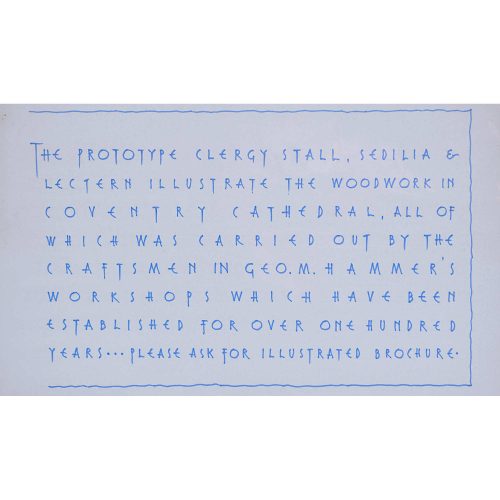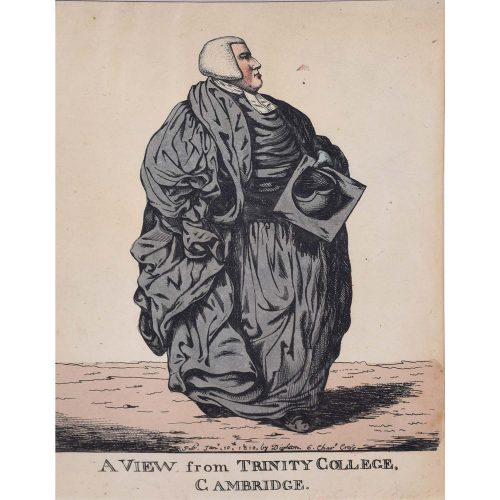-
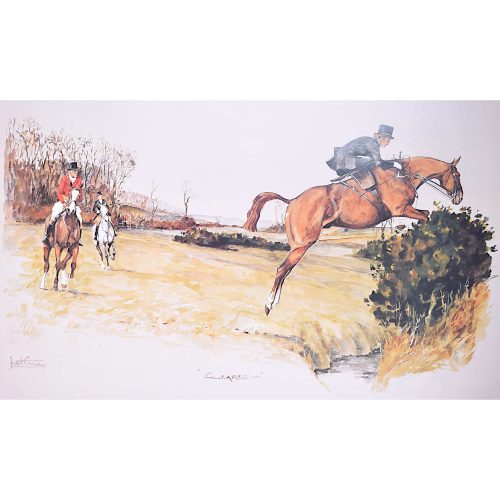
Daniel Crane (b. 1969) 'Cleared'
Limited edition print Signed in pencil and numbered 168/250 40x60cm One of the UK's leading sporting artists, Crane was born in Norfolk and is the youngest son of a hunting family. He grew up with a love of animals, the countryside and fieldsports, acquiring a particular passion for fox hunting in his late teens. He has been whipper-in, Master and Field Master and therefore understands the whole hunting process, allowing his paintings to reflect his knowledge and love of the sport. He is artist in residence for the Household Cavalry, and has many prestigious commissions to his name including Frankel - the greatest racehorse of all time - and Valegro the World and Olympic Champion. In this print, Crane captures the thrill and exhilaration that comes from clearing a hedge in fine style. If you are interested email info@manningfineart.co.uk or call us on 07929 749056. Condition: Never previously framed and in excellent condition. -
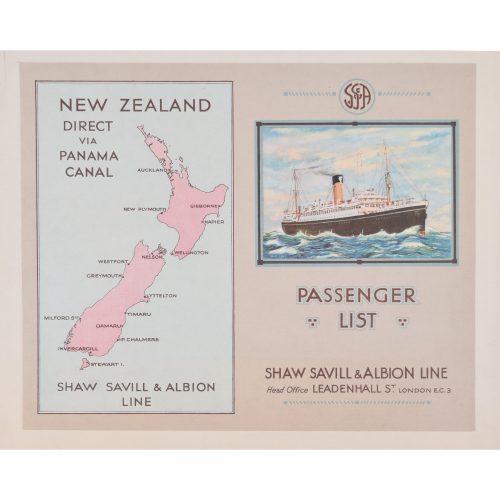
A E Agar (artist) Original passenger list brochure for Shaw Savill Albion Line, c. 1940s or 1950s.
24x34cm (approx) Provenance: the artist's estate As new, unissued printer's proof. Could be trimmed to the brochure size if desired. Fine image of ocean liner to front cover, map - via Panama Canal - to back cover. From the great age of Ocean Liners. If you are interested email info@manningfineart.co.uk or call us on 07929 749056. Condition: Excellent. -

Emery Walker (1851 - 1933) after Edmund Hort New (1871 - 1931)
Wadham College, Oxford
Photogravure 27 x 41 cm New produced a series of pen-and-ink drawings of Oxford colleges, of which this is one. They paid homage to the artist David Loggan, often using the same aerial viewpoint as him, but showing the colleges two hundred years later. Emery Walker turned New's drawings into photoengravings in the early 20th century. Probably no more than two hundred prints of each engraving were produced, and the plates were destroyed in the blitz. Edmund Hort New was an English artist. He was a member of the Birmingham Group of Arts and Crafts-associated painters and craftsmen, and is known as a leading illustrator of his period. He specialised in pen and ink drawings of rural and urban landscapes, old buildings and their interiors, architectural features, and also designed bookplates. He provided illustrations for the English Illustrated Magazine and was commissioned by Bodley Head publishers to illustrate critically acclaimed editions of books, such as Walton's The Compleat Angler. In 1895, New met William Morris and began designing for the Kelmscott Press. He also taught drawing to T E Lawrence. In 1905, he began his drawings of the Oxford colleges, and spent the rest of his life working on the (sadly unfinished) project. In 1921 he exhibited at the first exhibition of the Society of Graphic Art. Sir Emery Walker FSA was an English engraver, photographer, and printer. He was very involved with the Arts and Crafts movement, a Master of the Art Workers' Guild, President of the Arts and Crafts Exhibition Society, a Trustee of the Wallace Collection, and a Fellow of the Society of Antiquaries. He was also a close friend of William Morris. Walker's expertise and his collection of 16th-century typefaces inspired Morris to create the Kelmscott Press. In 1910, Walker photographed the notable Rice portrait of Jane Austen. He was knighted in 1930. Condition: very good; modern printing. If you’d like to know more, please email info@manningfineart.co.uk or call us on 07929 749056. Click here for other views of Wadham. -
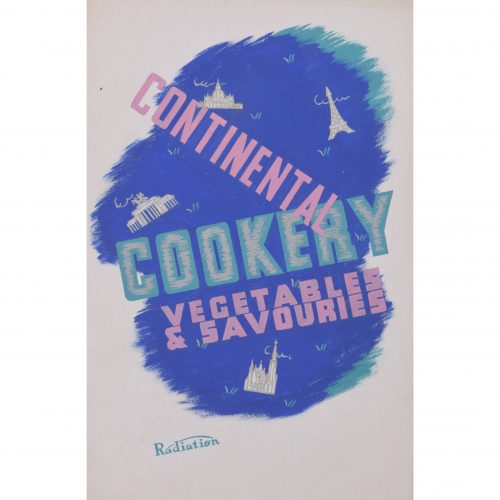
Brownbridge (flourished 1930s - 1940s)
Continental Cookery Radiation cooker brochure design
Gouache 21.5 x 14 cm From a small archive of works by Brownbridge, a member of the Society of Industrial Artists. A beautiful original gouache design for a brochure of continental recipes, created to advertise Radiation cookers (innovative gas cookers which were sold in Britain in the 1920s and 1930s). Brownbridge's brightly-coloured design includes boldly slanted text in pink and turquoise, set over a deep blue background; he also highlights architectural gems of Europe, such as the Eiffel Tower. By cooking with a Radiation cooker, the cover suggests, you too can experience the cultural and culinary delights of Europe from the comfort of your own home. Society of Industrial Artists correspondance (photographed above) is not included; please enquire separately. Condition: generally very good. If you are interested, please email info@manningfineart.co.uk or call us on 07929 749056. Click here for other designs by Brownbridge. -
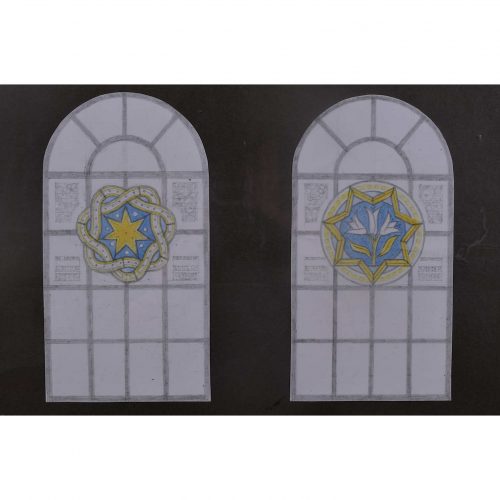
Jane Gray (b.1931)
St Mary’s Church, Twickenham, Middlesex, Design for Stained Glass Memorial Windows (1988)
Watercolour 15.5 x 17 cmSigned, dated and studio stamp verso.
St Mary’s Church stands on the site of an earlier church in Twickenham, a short distance from York House and the banks of the River Thames, and incorporates a 15th-century, medieval tower. St Mary's has an impressive and illustrious history of notable parishioners including the painter Godfrey Kneller who, after the collapse of the ancient church's 14th-century nave in 1714, took active involvement in redesigning the church in the Neo-classical style alongside local architect John James, as well as Henry Fielding and Alfred Lord Tennyson whose sons were both baptised here. Gray had a personal connection to St Mary’s, her great grandfather having been the vicar some years before. These windows held especial personal meaning for Gray as they commemorated the death of her parents in 1982 and 1985 respectively. The windows were installed in 1989.
Provenance: the artist’s studio sale. Literature: Jane Gray, Playing with Rainbows. (Shropshire: Ellingham Press, 2011), pp.42-3, 80. Condition: very good. If you are interested, please email info@manningfineart.co.uk or call us on 07929 749056. For other works by Jane Gray and more information about her, please click here. -

Jane Gray (b.1931)
St John’s Church, Pool Quay, Design for Stained Glass Roundel (2005)
Watercolour D.14 cmSigned and studio stamp verso.
St John's Church was built in 1861 under the patronage of the third Earl of Powys to provide for the religious needs of the largely industrial population of Pool Quay. The church was originally designed in the Early English style but was extensively restored first in 1956 and again in 2003/4. Despite this, it still retains its unique charm, built in the instantly recognisable red Sweeney Mountain sandstone, and features stained glass windows by Winfield of Birmingham (1891) and Camm of Smethwick (1899). This design by Gray features eight lights containing attributes of St John and other Christian symbols.
Provenance: the artist’s studio sale. Literature: Jane Gray, Playing with Rainbows. (Shropshire: Ellingham Press, 2011), p.89. Condition: very good. If you are interested, please email info@manningfineart.co.uk or call us on 07929 749056. For other works by Jane Gray and more information about her, please click here. -
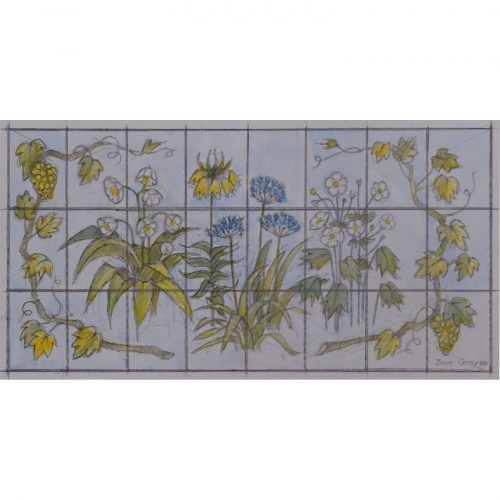
Jane Gray (b.1931)
Saling Hall, Essex, Design for Stained Glass Window (1980)
Watercolour 11 x 20 cmSigned and dated.
Saling Hall, in Essex, has a long and rich history, dating back to the early 12th century when Sir Baldwin Wiscart was the first recorded Lord of the Manor. After his his son, the house passed to the knightly family of Bibbesworth, who lived there for four generations. Sir Walter de Bibbesworth was a crusader and a poet (in French). Nothing remains of the first Saling Hall which was rebuilt around 1590 by the Maxey family who had bought the hall in 1487. The house faced further remodelling by its 17th century owner, Martin Carter, a lawyer. He ornamented the new facade with Dutch gables, which are the latest example of their kind in Essex, and the house has changed little since. The hall passed through many more hands before it was bought, in 1935, by Lady Isabella Carlyle (née Barton) who was a passionate gardener and gave the Hall its first modern gardens. Lady Carlyle sold the Hall in 1971 to Hugh Johnson, a well known garden writer, who continued Lady Carlyle’s work on the gardens. This design is a final drawing for a stained glass window commissioned by Johnson for a fanlight in Saling Hall. Johnson wished the design to include the plants he grew in his own garden to symbolise the seasons. Gray designed the panel using Corsican Hellebore for winter, the Crown Imperial Fritillary for spring, Agapanthas for summer, and Japanese Anemones for autumn. Gray also included vines to frame the design and nod to Johnson’s oenological interests.
Provenance: the artist’s studio sale. Literature: Jane Gray, Playing with Rainbows. (Shropshire: Ellingham Press, 2011), p.40. Condition: very good. If you are interested, please email info@manningfineart.co.uk or call us on 07929 749056. For other works by Jane Gray and more information about her, please click here. -
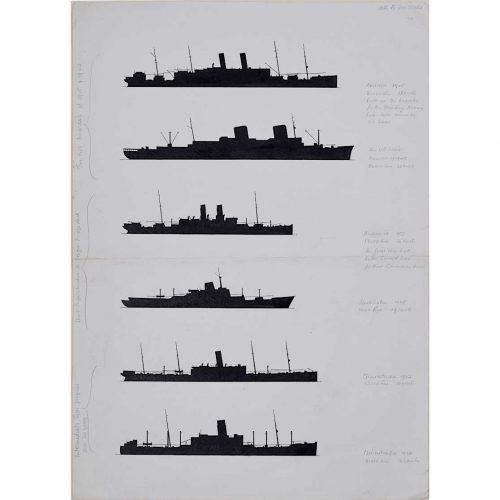
Laurence Dunn (1910-2006)
A Series of Coastal Tramp Silhouettes
34.5 x 24 cm Bodycolour on paper Dunn’s depictions of coastal tramps are early works, likely captured from the side of the Thames estuary near his home. This work contains extensive notes on the featured ships.Laurence Dunn (1910-2006) was a well-known British marine artist and writer known for his depictions of ships. He grew up in Devon, where he practised drawing passing ships, and went on to study at the Central School of Art. He then worked for shipbuilding firm John I. Thornycroft & Company Limited, where he contributed to the design of the Royal Yacht. During the Second World War, Dunn worked in naval intelligence. In the early 1960s, he created many line drawings of Atlantic ocean liners.
Upon his death in 2006, the World Ship Society published the following obituary:
DUNN, Laurence. [December 15 2006 — Lloyds List] Many readers will be saddened by the death of well-known marine artist and writer Laurence Dunn in his 97th year. A man of encyclopaedic knowledge, he began his lifelong love of ships in Brixham, where he meticulously recorded passing traffic with the exquisitely accurate line drawings which later became something of a trademark. While studying at London’s Central School of Art his work was noticed by the Southern Railway, which commissioned profiles of its fleet, and this in turn led to work for Orient Line, where he also designed the well-known corn-coloured hull, and later Thorneycroft, where he helped with shaping draft plans for a new royal yacht. During the second world was he worked for naval intelligence at the Admiralty, where his technique did much to improve recognition standards, and greatly expanded his shipping clientele, becoming personally known to many chairmen. As well as the shipping press he worked for mainstream publications such as Everybody’s, Sphere and the upmarket comic Eagle. Through his many contacts he enjoyed going to sea in a great variety of ships from aircraft carriers to colliers. Laurence wrote several books, starting with ship recognition titles which introduced new standards of layout, but his best known work was probably Passenger Liners, which was widely taken up by the travel trade. His love of Greece, where he was an early publicist of island cruising, let to involvement in reshaping various passenger liners beginning with Greek Line’s OLYMPIA. In later life he designed several sets of shipping stamps for the Crown Agents, produced photographic volumes on Thames and Mediterranean shipping and still found time to enjoy the passing Thames traffic. Our sympathies go to his wife Jennifer, who provided succour to the many ship lovers who beat a path to the welcoming door of their Gravesend home.
-
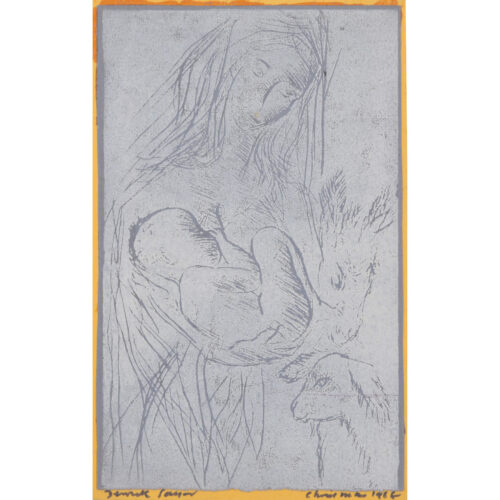
Derrick Latimer Sayer (1917 - 1992)
Madonna and Child (Christmas Card)
Linocut 21 x 13.5 cm Mounted to card, signed 'Derrick Sayer' and dated Christmas 1968. Sayer's linocut of the Virgin Mary and baby Jesus is hauntingly emotive; his spare use of line shows Mary, eyes closed, cradling her newborn son. Two animals from the stable in Bethlehem look on. Sayer studied at the Chelsea School of Art under Graham Sutherland and Henry Moore, and then in Paris in Ben Nicholson's studio. In the late 1930s he was in Cornwall, founding the Mousehole Group Art School. He was well known for his work as a poster artist and book illustrator. Condition: very good. If you are interested, please email info@manningfineart.co.uk or call us on 07929 749056. -
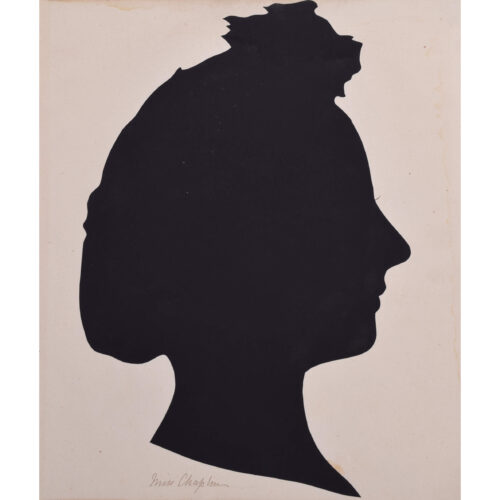
Silhouette (circa 1870)
Miss Chaplin
Gouache, pen, and ink 52 x 44 cm Prior to photography, silhouettes were the easiest way of recording a person's appearance. This set might record the group present at a country house party, a wedding, or other similar convivial occasion. Condition: good. Some staining at upper and right edges. If you are interested, please email info@manningfineart.co.uk or call us on 07929 749056. Click here for other silhouettes. -
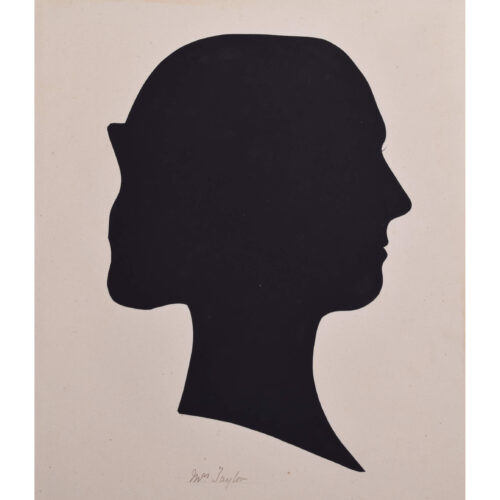
Silhouette (circa 1870)
Mrs Taylor
Gouache, pen, and ink 52 x 44 cm Prior to photography, silhouettes were the easiest way of recording a person's appearance. This set might record the group present at a country house party, a wedding, or other similar convivial occasion. Condition: generally very good. If you are interested, please email info@manningfineart.co.uk or call us on 07929 749056. Click here for other silhouettes. -

Silhouette (circa 1870)
Mrs Warburton
Gouache, pen, and ink 52 x 44 cm Prior to photography, silhouettes were the easiest way of recording a person's appearance. This set might record the group present at a country house party, a wedding, or other similar convivial occasion. Condition: generally very good; some light staining at upper edge. If you are interested, please email info@manningfineart.co.uk or call us on 07929 749056. Click here for other silhouettes. -
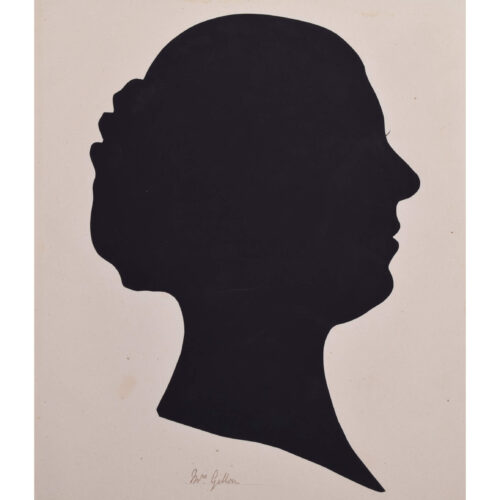
Silhouette (circa 1870)
Mrs Gillon
Gouache, pen, and ink 52 x 44 cm Prior to photography, silhouettes were the easiest way of recording a person's appearance. This set might record the group present at a country house party, a wedding, or other similar convivial occasion. Condition: generally very good; some light staining. If you are interested, please email info@manningfineart.co.uk or call us on 07929 749056. Click here for other silhouettes. -
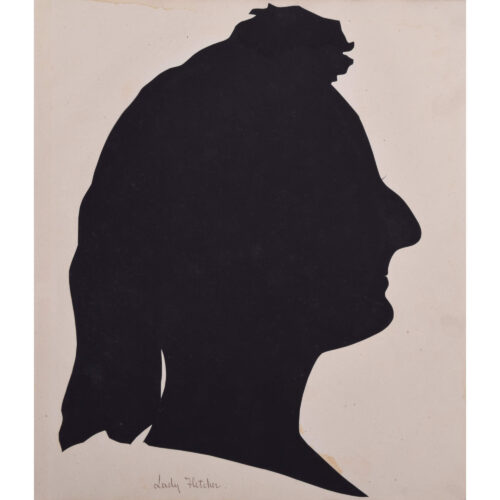
Silhouette (circa 1870)
Lady Fletcher
Gouache, pen, and ink 52 x 44 cm Prior to photography, silhouettes were the easiest way of recording a person's appearance. This set might record the group present at a country house party, a wedding, or other similar convivial occasion. Condition: generally very good; some light staining to right edge. If you are interested, please email info@manningfineart.co.uk or call us on 07929 749056. Click here for other silhouettes. -
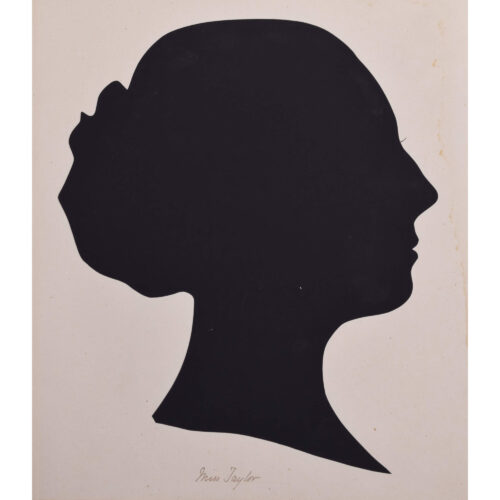
Silhouette (circa 1870)
Miss Taylor
Gouache, pen, and ink 52 x 44 cm Prior to photography, silhouettes were the easiest way of recording a person's appearance. This set might record the group present at a country house party, a wedding, or other similar convivial occasion. Condition: good; some staining to right edge. If you are interested, please email info@manningfineart.co.uk or call us on 07929 749056. Click here for other silhouettes. -
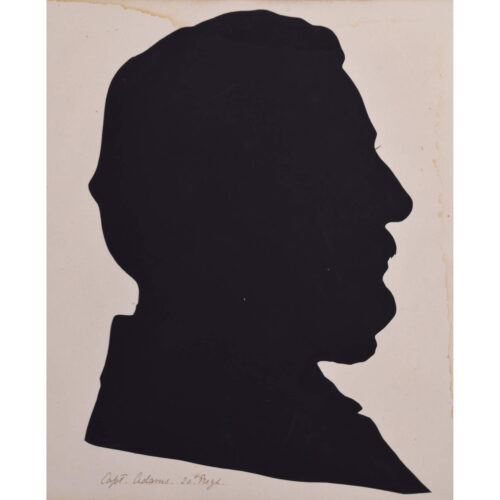
Silhouette (circa 1870)
Captain Adams, 20th Regt
Gouache, pen, and ink 52 x 44 cm Prior to photography, silhouettes were the easiest way of recording a person's appearance. This set might record the group present at a country house party, a wedding, or other similar convivial occasion. Condition: generally good; some staining to upper and right margins. If you are interested, please email info@manningfineart.co.uk or call us on 07929 749056. Click here for other silhouettes. -
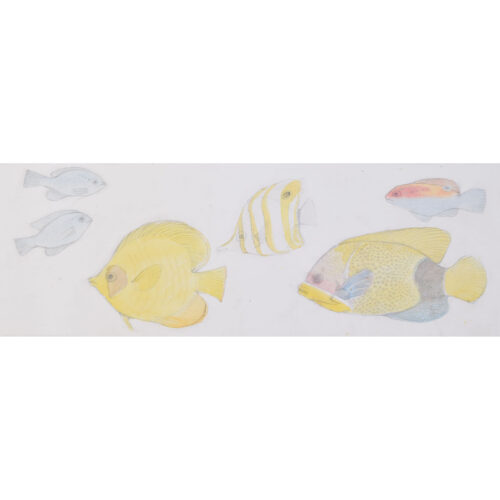
Jane Gray (born 1931)
Fish (1960)
Pencil and watercolour 19 x 54 cm Provenance: the artist's studio sale. Jane Gray A.R.C.A. (b.1931) is a British stained glass artist. She studied stained glass at the Kingston School of Arts (1949 - 1951) and later at the Royal College of Art (1951 - 1955) under Lawrence Lee. Lee was so impressed with Gray’s work that he asked her to work alongside him on the design of ten nave windows for Coventry Cathedral. This six-year-long design project culminated in their final installation in 1962 after the cathedral’s consecration. Gray was the first woman to become a liveryman of the Worshipful Company of Glaziers and has designed more than a hundred windows in private and public buildings, chapels and over forty churches across the country, including St Peter’s, Martindale, Shrewsbury Abbey, St Oswald, Oswestry and St Mary, Chirk. Gray’s designs mark a crucial turning point in the history of stained glass art as the Victorian style gave way to a modern, aesthetic. In her work, Gray navigates this shift with a style that, whilst distinctly modern, retains a deep rooted sense of the medieval. Despite many of her commissions being for church windows, stained glass design was not simply about religious depiction for Gray, but more about ‘colour, shapes, luminosity, [and] playing with rainbows’. Condition: generally very good. If you are interested, please email info@manningfineart.co.uk or call us on 07929 749056. For other works by Jane Gray and more information about her, please click here. -

Richard Bankes Harraden (1778 - 1862)
Christ's College, Cambridge
Engraving 15 x 22 cm A nineteenth-century view of Christ's College, Cambridge, complete with two academics and a street-sweeper. Richard Bankes Harraden was a printmaker, painter, and drawing master. He was active in Cambridge, producing many views of the colleges, and subsequently several Oxford colleges. Harraden was an early and exhibiting member of the Society of British Artists in London, which was established in 1823, and remained a member until 1849. He specialised in depictions of landscape, topography and architecture, and was the son of Richard Harraden (1756 - 1838) with whom he published plates as 'Harraden & Son'. Condition: generally very good; a little discolouration to paper; in handsome washlined mount. If you are interested, please email info@manningfineart.co.uk or call us on 07929 749056. Click here for other views of Christ's College, Cambridge. -
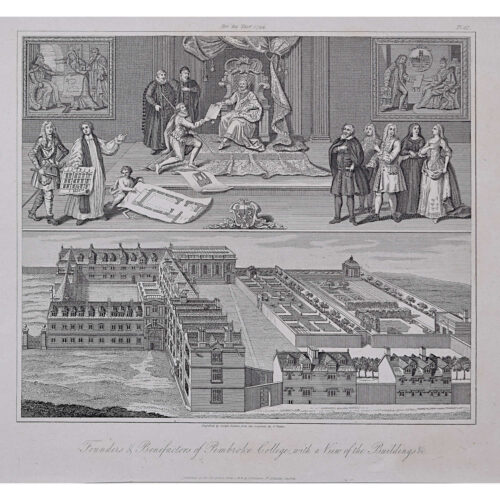
Joseph Skelton (1783 - 1871) after George Vertue (1684 - 1756)
Founders & Benefactors of Pembroke College, with a View of the Buildings &c. (1818)
Engraving 21 x 24 cm A historic engraving of Pembroke's august founders and early architecture, which later formed part of the artist's 1828 'Pietas Oxoniensis, or Records of Oxford Founders'. George Vertue FSA was an English engraver and antiquary. He was apprenticed to a heraldic engraver in France, then worked for the Flemish engraver Michael Vandergucht before setting up on his own. He was also a student of the English portrait painter and copyist Thomas Gibson. He became the official engraver to the Society of Antiquaries when it was founded in 1717, and his patrons included several British aristocrats. He is buried in Westminster Abbey. Joseph Skelton was an a topographical and antiquarian engraver. He lived in Oxford for a time and became a Fellow of the Society of Antiquaries of London. His Oxford publications include the Oxonia Antiqua Illustrata; Antiquities of Oxfordshire, from drawings by F. Mackenzie; and the Pietas Oxoniensis, or Records of Oxford Founders. Condition: generally very good. If you are interested, please email info@manningfineart.co.uk or call us on 07929 749056. Click here for other views of Pembroke College, Oxford. -
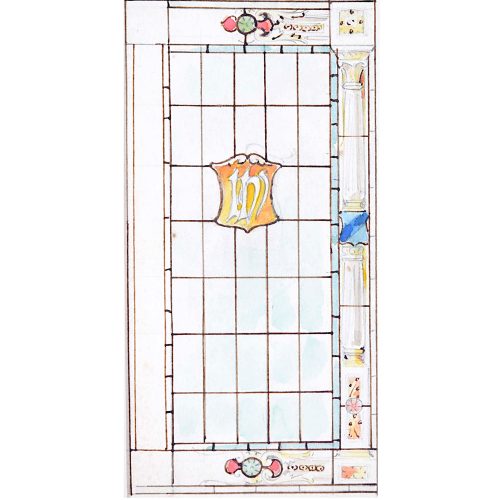
Florence Camm (1874-1960) Design for church stained glass window with 'IHS' roundel
Watercolour 17x9 cm Design for TW Camm & Co., Smethwick, Birmingham With 'IHS' Roundel - 'Iesus Hominum Salvator' ('Jesus Saviour of Mankind') The Camms were stained glass designers who exhibited 48 times at the Royal Academy and also exhibited at The Walker Art Gallery in Liverpool, The Royal Scottish Academy and Royal Birmingham Society of Artists. Following the death of her father, Florence Camm became chief designer at TW Camm with many commissions both nationally and internationally. Florence Camm was the daughter of Thomas William Camm (1839-1912) who founded the stained glass business T W Camm in High Street Smethwick. From 1892-1911 she studied at The Birmingham Municipal School of Art which, unusually for the time, encouraged girls to attend the life drawing classes – drawing fully nude female models and partially draped male models – thus explaining Camm’s skill with the human figure. Students were encouraged to execute their drawings for designs, thus giving them the skills to set up as manufacturers in Birmingham’s Jewellery Quarter. The arts and crafts designer Henry Payne was an influential tutor for Camm, being one of the most influential teachers at the BMSA who was working as a stained glass designer at the time; one of his most notable commissions was a painted mural illustrating Tudor History for the Houses of Parliament in 1908. Following the death of TW Camm, Florence and her brothers – Walter and Robert – took over the business and Florence did most of the designing. If you are interested email info@manningfineart.co.uk or call us on 07929 749056. Condition: In conservation mount and in plastic sleeve for protection. -
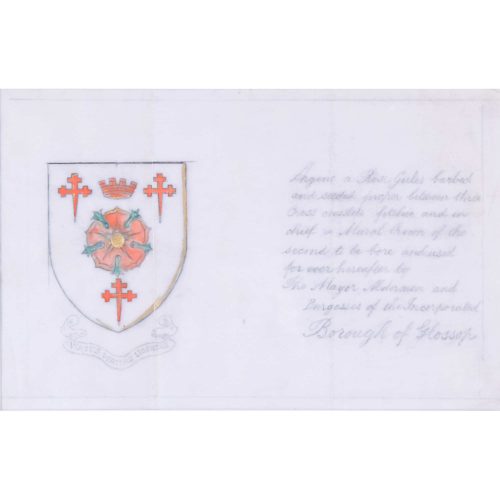
Florence Camm (1874-1960) Design for stained glass window for the Arms of the Borough of Glossop
Watercolour on tracing paper 18x28 cm Design for TW Camm & Co., Smethwick, Birmingham The Camms were stained glass designers who exhibited 48 times at the Royal Academy and also exhibited at The Walker Art Gallery in Liverpool, The Royal Scottish Academy and Royal Birmingham Society of Artists. Following the death of her father, Florence Camm became chief designer at TW Camm with many commissions both nationally and internationally. Florence Camm was the daughter of Thomas William Camm (1839-1912) who founded the stained glass business T W Camm in High Street Smethwick. From 1892-1911 she studied at The Birmingham Municipal School of Art which, unusually for the time, encouraged girls to attend the life drawing classes – drawing fully nude female models and partially draped male models – thus explaining Camm’s skill with the human figure. Students were encouraged to execute their drawings for designs, thus giving them the skills to set up as manufacturers in Birmingham’s Jewellery Quarter. The arts and crafts designer Henry Payne was an influential tutor for Camm, being one of the most influential teachers at the BMSA who was working as a stained glass designer at the time; one of his most notable commissions was a painted mural illustrating Tudor History for the Houses of Parliament in 1908. Following the death of TW Camm, Florence and her brothers – Walter and Robert – took over the business and Florence did most of the designing. If you are interested email info@manningfineart.co.uk or call us on 07929 749056. Condition: In conservation mount and in plastic sleeve for protection. -
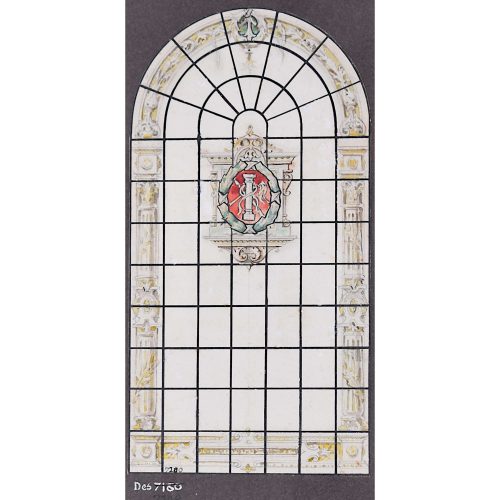
Florence Camm (1874-1960) Design for stained glass window 'The Instruments of the Passion'
Watercolour 20x10 cm Design for TW Camm & Co., Smethwick, Birmingham embossed with their stamp to bottom Numbered 7180/7200 The Camms were stained glass designers who exhibited 48 times at the Royal Academy and also exhibited at The Walker Art Gallery in Liverpool, The Royal Scottish Academy and Royal Birmingham Society of Artists. Following the death of her father, Florence Camm became chief designer at TW Camm with many commissions both nationally and internationally. Florence Camm was the daughter of Thomas William Camm (1839-1912) who founded the stained glass business T W Camm in High Street Smethwick. From 1892-1911 she studied at The Birmingham Municipal School of Art which, unusually for the time, encouraged girls to attend the life drawing classes – drawing fully nude female models and partially draped male models – thus explaining Camm’s skill with the human figure. Students were encouraged to execute their drawings for designs, thus giving them the skills to set up as manufacturers in Birmingham’s Jewellery Quarter. The arts and crafts designer Henry Payne was an influential tutor for Camm, being one of the most influential teachers at the BMSA who was working as a stained glass designer at the time; one of his most notable commissions was a painted mural illustrating Tudor History for the Houses of Parliament in 1908. Following the death of TW Camm, Florence and her brothers – Walter and Robert – took over the business and Florence did most of the designing. If you are interested email info@manningfineart.co.uk or call us on 07929 749056. Conditon: Good. In plastic sleeve for protection. -

Eric Gill
Initial Letter 'H' for The Canterbury Tales (1929) - The Doctor's Tale
Woodblock Print Published Hague & Gill 1934 in an unnumbered edition of 300 23x21cm Following Chichester Technical and Art School, Gill moved to London in 1900 to train with the ecclesiastical architects W D Caroe. Finding architecture somewhat pedestrian he took stonemasonry lessons at Westminster Technical Institute and calligraphy lessons at the Central School of Arts and Crafts, coming under the influence of Edward Johnson, the designer of the London Underground's own typeface. In 1903 he ceased his attempts to become an architect, instead becoming a monumental mason, letter-cutter and calligrapher. Based in Ditchling, he began direct carving of stone figures, the semi-abstract figures taking their influence from mediaeval statuary, mixed with influences from Classical statuary from the Greeks and Romans, with a little post-Impressionism added in. With major commissions from Westminster Cathedral for its Stations of the Cross (1914), a series of War Memorials including the Grade II* memorial in Trumpington, and three of the sculptures for Charles Holden's 1928 headquarters of London Underground at 55 Broadway, St James's, and a series of sculptures for the new 1932 Broadcasting House. The list continues. Never one to rest on his laurels, he was at the same time engaged in typographical adventures. He had collaborated with Edward Johnson on the latter's initial thoughts on his London Transport typeface, but in 1925 designed Perpetua on his own, and Gill Sans between 1927-30. For the Golden Cockerel Press he created, in 1929, a bolder typeface to complement wood engravings. And of course Gill was publishing decorated books. His 1929 Canterbury Tales was an epic work, with a whole series of beautiful wood engravings such as this one. The present print is from the 1934 edition for Faber & Faber ('Engravings 1928-1933 by Eric Gill') he printed with his son-in-law, Rene Hague, produced with the original engraved wood blocks. In Chaucer's Tales, the Summoner's Tale tells the story of the man who summonsed people to the ecclesiastical courts. It satirises the friar, considering him to be corrupt. Philip Hofer was a curator and collector, and commissioned this fine Ex Libris plate from Gill. If you are interested email info@manningfineart.co.uk or call us on 07929 749056. Condition: Generally very good condition. -
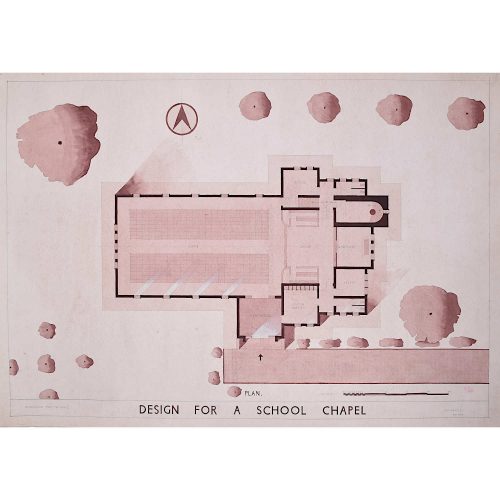
V A Hards (British, c. 1930-c. 2012) Design for Modernist School Chapel
Watercolour on wove Signed and dated November 1948 and marked 35/40 55x77cm Hards was educated at Brixton School of Building and Woolwich Polytechnic between 1948 and 1956, during which period he produced some very competent work including this rather fun modernist design for a riverside tearoom. Brixton School of Building was incorporated into the Polytechnic of the South Bank - now London South Bank University. If you are interested email info@manningfineart.co.uk or call us on 07929 749056. Condition: Some edge wear and isolated spots. -
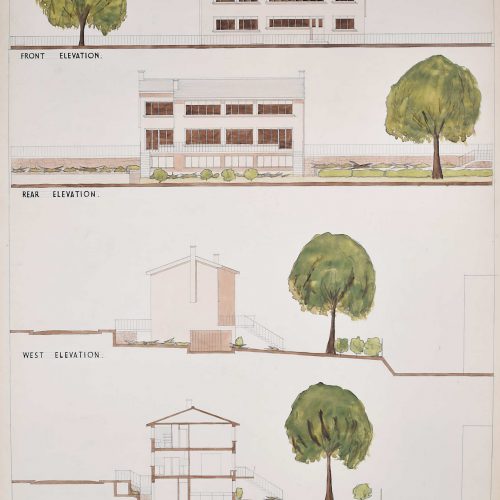
V A Hards (British, c. 1930-c. 2012) Design for Modernist Town House
Watercolour on wove Signed and dated October 1949 and inscribed Woolwich Polytechnic. 77x55cm Hards was educated at Brixton School of Building and Woolwich Polytechnic between 1948 and 1956, during which period he produced some very competent work including this rather fun modernist brutalist design for a town house. Brixton School of Building was incorporated into the Polytechnic of the South Bank - now London South Bank University. If you are interested email info@manningfineart.co.uk or call us on 07929 749056. Condition: Some edge wear and isolated spots. -

V A Hards (British, c. 1930-c. 2012) Design for Monumental Fountain
Watercolour on wove Signed and dated 1955 55x77cm Hards was educated at Brixton School of Building and Woolwich Polytechnic between 1948 and 1956, during which period he produced some very competent work including this rather fun modernist design for a monumental fountain in a grand park. Brixton School of Building was incorporated into the Polytechnic of the South Bank - now London South Bank University. If you are interested email info@manningfineart.co.uk or call us on 07929 749056. Condition: Some edge wear and isolated spots. -
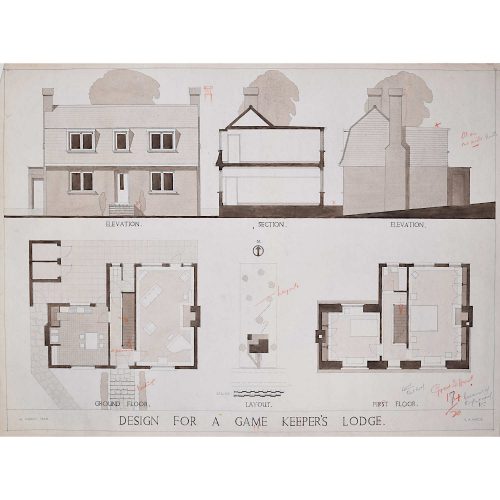
V A Hards (British, c. 1930-c. 2012) Design for Modernist Game Keeper Lodge
Watercolour on wove Signed and dated March 1948 55x77cm Hards was educated at Brixton School of Building and Woolwich Polytechnic between 1948 and 1956, during which period he produced some very competent work including this rather fun modernist design for a monumental fountain in a grand park. Brixton School of Building was incorporated into the Polytechnic of the South Bank - now London South Bank University. If you are interested email info@manningfineart.co.uk or call us on 07929 749056. Condition: Some edge wear and isolated spots . -

V A Hards (British, c. 1930-c. 2012) Design for Modernist Town House
Watercolour on wove Signed and dated October 1949 and inscribed Woolwich Polytechnic. 77x55cm Hards was educated at Brixton School of Building and Woolwich Polytechnic between 1948 and 1956, during which period he produced some very competent work including this rather fun modernist brutalist design for a town house. Brixton School of Building was incorporated into the Polytechnic of the South Bank - now London South Bank University. If you are interested email info@manningfineart.co.uk or call us on 07929 749056. Condition: Some edge wear and isolated spots. -

V A Hards (British, c. 1930-c. 2012) Design for Modernist Fisherman's Hut
Watercolour on wove Signed and dated March 1956 and stamped for Brixton School of Building. 77x55cm Hards was educated at Brixton School of Building and Woolwich Polytechnic between 1948 and 1956, during which period he produced some very competent work including this rather fun modernist brutalist design for a fisherman's hut, not designed to blend in with the scenery. Brixton School of Building was incorporated into the Polytechnic of the South Bank - now London South Bank University. To view more of his work we have listed, scroll down to 'View more from this seller' and click on 'View all from this seller' and then search for 'Hards'. If you are interested email info@manningfineart.co.uk or call us on 07929 749056. Condition: Good. Some edge wear and isolated spots. -
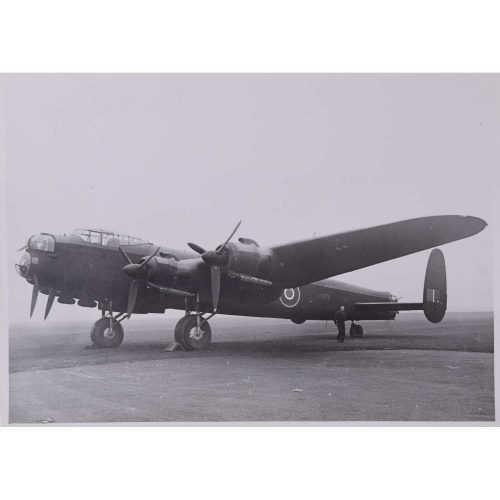
Lancaster LL678 'Lily Mars' - 1
Silver Gelatin photograph, December 1943 12 x 16 cm Stamped to reverse 'The Photograph has been passed by Censor' 'Copyright This TP copyright illustration from "The Aeroplane" must not be reproduced without the written permission of Temple Press Ltd'. 'A general view of an Avro Lancaster II with Hercules radial motors.' 300 Lancaster II aeroplanes were made, fitted with Bristol Hercules radial engines, as there was a worry that there would be a shortage of Merlin engines, reserved for the Spitfire and Hurricane. Lily Mars was named after the 1943 American musical starring Judy Garland and was based at RAF Waterbeach, in Cambridgeshire. An excellent podcast (click) gives details of the final flight on 13 June 1944 which was to be the final raid of the crew's tour. The bombing raid was of 303 Lancasters against the Nordstern synthetic oil plant at Gelsenkichen in the Ruhr, deep inside Germany and the aircraft took off at 23.12 hrs. On the home run LL678 was intercepted and shot down by a night fighter capitained by Oberleutnant Schmidt in a Bf 110 at 01.24 hrs at Zuidloo, a small hamlet, where five of the eight crew are buried; the other three crew members baled out and escaped. A memorial plaque was laid on 4 May 2016 and a Lancaster flypast was arranged. Owing to technical problems a Dakota from the BBMF was sent instead. On 4 May 2022 the Lancaster of the BBMF undertook a flypast which can be seen here. Dietrich Schmidt (1919-?) had 29 confirmed night kills by the time of LL678, achieving 41 kills by the end of the war off 171 missions and was awarded the Ritterkreuz - Knight's Cross. In 1999 the living crewmembers, Dutch resistance and Schmidt and his wireless operator met in the Netherlands.

